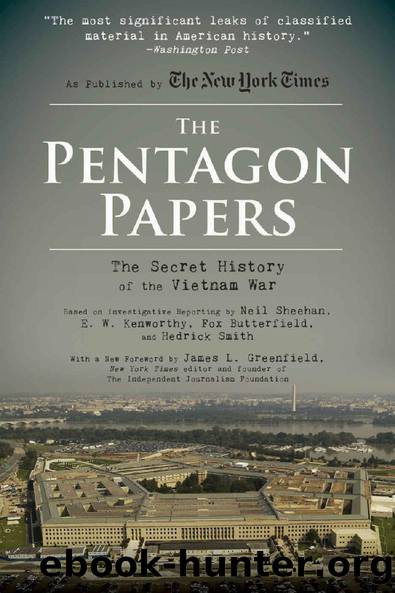The Pentagon Papers: The Secret History of the Vietnam War by Sheehan Neil & Smith Hedrick & E. W. Kenworthy & Butterfield Fox

Author:Sheehan Neil & Smith Hedrick & E. W. Kenworthy & Butterfield Fox [Neil, Sheehan]
Language: eng
Format: epub
ISBN: 9781631582936
Publisher: Skyhorse Publishing
Published: 2017-12-12T07:00:00+00:00
Chapter 7
The Launching of the Ground War:
March-July, 1965
Highlights of the Period: March-July, 1965
Within a month of the start of Operation Rolling Thunder, the Pentagon study says, the Johnson Administration had made the first of the decisions that were to lead, in the next months, to American assumption of the major burden of the ground war in South Vietnam.
Here, in chronological order, are highlights of these months:
MARCH 1965
The first âRolling Thunderâ air strike hit an ammunition depot and a naval base. Two Marine batallions were deployed in Vietnam.
APRIL 1965
The President approved an 18,000-20,000-man increase in âmilitary support forcesâ and âa change of missionâ for the marines âto permit their more active use . . .â Memo noted his desire for âall possible precautionsâ against âpremature publicityâ and to âminimize any appearance of sudden changes in policy.â
John T. McNaughton, Assistant Secretary of Defense for International Security Affairs, urged that the 173rd Airborne Brigade also be deployed.
Ambassador Maxwell D. Taylor called this âhasty and ill-conceived.â
The conferees at a Honolulu strategy meeting agreed to urge an increase in U.S. troops to 82,000.
George W. Ball, Under Secretary of State, proposed that the U.S. âcut its lossesâ and withdraw instead, the study says.
MAY 1965
The Vietcong âsummer offensiveâ began, the analyst says. There were about 200 Marine casualties during April and May.
JUNE 1965
Gen. William C. Westmoreland, commander in Vietnam, said the U.S. must âreinforce our efforts . . . as rapidly as practical.â He asked for a total of 44 battalions.
The State Department announced that U.S. troops were âavailable for combat support.â
The first major ground action by U.S. forces took place northwest of Saigon.
Gen. Westmoreland, in reply to the Joint Chiefs, made a âbig pitch . . . for a free hand to maneuver the troops around . . .â the analyst says.
Ambassador Taylor âconfirms the seriousness of the military situationâ and the âvery tenuous holdâ of the new government, the study goes on.
General Westmoreland was given the authority to use U.S. forces in battle when necessary âto strengthenâ South Vietnamese forces.
Mr. Ball, the analyst writes, opposed the increase in ground troops, saying it gave âabsolutely no assuranceâ of success and risked a âcostly and indeterminate struggle.â He urged a âbase defense and reserveâ strategy âwhile the stage was being set for withdrawal.â
William P. Bundy, the history says, urged the President to avoid the âultimate aspectsâ of both the Ball and Westmoreland proposals. He said that U.S. troops should be limited to a supporting, âreserve reactionâ role.
JULY 1965
The President initially approved the deployment of 34 battalions, about 100,000 men; 44 battalions were finally agreed to, for a total of 193,887 troops.
The history says this decision was âperceived as a threshholdâentrance in Asian land war . . .â
By the end of the year, the history notes, U.S. forces in South Vietnam totaled 184,314.
Download
This site does not store any files on its server. We only index and link to content provided by other sites. Please contact the content providers to delete copyright contents if any and email us, we'll remove relevant links or contents immediately.
| Africa | Americas |
| Arctic & Antarctica | Asia |
| Australia & Oceania | Europe |
| Middle East | Russia |
| United States | World |
| Ancient Civilizations | Military |
| Historical Study & Educational Resources |
The Light of Days by Judy Batalion(827)
Stalin's War: A New History of World War II by Sean McMeekin(687)
Walk in My Combat Boots by James Patterson(613)
The Pacific War 1941-1943 by James Holland(608)
Victory's Price (Star Wars) by Alexander Freed(576)
The Vietnam War: An Intimate History by Geoffrey C. Ward & Ken Burns(568)
First Platoon: A Story of Modern War in the Age of Identity Dominance by Annie Jacobsen(562)
Cold War (Alexander King Book 2) by Bradley Wright(557)
The American War in Afghanistan by Carter Malkasian(555)
Operation Pedestal by Max Hastings(538)
Blood and Ruins: The Great Imperial War, 1931-1945 by Richard Overy(530)
The Madman Theory by Jim Sciutto(521)
Concepts of Space by Jammer Max;(515)
Extreme Fitness by Chris McNab(514)
World War II Infantry Fire Support Tactics by Gordon L. Rottman(501)
Flying Tiger by Samson Jack(500)
Pathfinders by AL-KHALILI JIM(496)
Panzerkrieg by Mike Syron(488)
Hitler’s Pre-Emptive War: The Battle for Norway, 1940 by Henrik O. Lunde(484)
